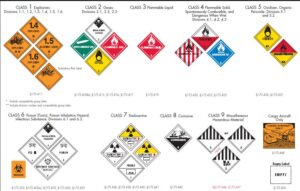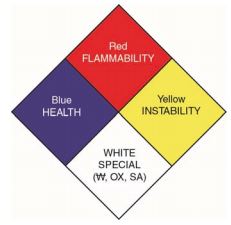Both the large quantity generator (LQG) and small quantity generator (SQG) of hazardous waste are required by Federal regulations of the United States Environmental Protection Agency (USEPA) to display hazard communication in the form of marks and labels on the hazardous waste accumulation units in use at their facility. This includes containers of hazardous waste in both the central accumulation area (CAA) and satellite accumulation area (SAA).
These – and other – Federal regulations changed with the effective date of the Generator Improvements Rule on May 30, 2017. Regulations now require the generator to indicate the hazards of the contents in addition to other required marks and labels.
The purpose of this article is to identify and explain the requirements of the Generator Improvements Rule for the display of hazard communication on hazardous waste containers in a satellite accumulation area per 40 CFR 262.15.
Before we begin…
This revision to the Federal regulations is more stringent than the regulations in existence prior to May 30, 2017. Therefore, all States must eventually adopt this requirement. Further, even if your State has not yet adopted the Generator Improvements Rule (see: Scope and Applicability), this new regulation is – I think – easy to comply with and a good idea.
The Generator Improvements Rule also included a significant reorganization of the Federal regulations. The regulations for accumulation of hazardous waste in SAA’s was moved from §262.34(c) to §262.15. Read: Reorganization of Federal Regulations Under the Generator Improvements Rule.
- Learn more about the satellite accumulation area
- Learn more about the central accumulation area
- Read everything I have on changes to the satellite accumulation area regulations by the Generator Improvements Rule.
- Read everything I have on the requirement to indicate the hazards on a hazardous waste accumulation unit under the Generator Improvements Rule.
|
Daniels Training Services, Inc. 815.821.1550 |
Scope and Applicability:
As of the date of this article, not every State has adopted the Generator Improvements Rule. Read: What is the status of the Generator Improvements Rule in my State? Since this particular regulation is more stringent than Federal regulations in affect prior to May 30, 2017, your State must eventually adopt this requirement. Regardless of the status of the Generator Improvements Rule in your State, you may comply with this regulation as a Best Management Practice.
A State with an authorized hazardous waste program may have regulations more stringent than those of the USEPA. It is quite possible your State may require more hazard communication than is described in this article even before the Generator Improvements Rule. Be sure to check with your state!
USEPA regulations identify three hazardous waste generator categories based on the amount of hazardous waste generated per calendar month:
- Large quantity generator (LQG)
- Small quantity generator (SQG)
- Very small quantity generator (VSQG)
This article is applicable to the LQG and SQG. A VSQG is not required to mark or label its hazardous waste containers nor will it accumulate hazardous waste in a SAA. Your state may not recognize all three generator categories or it may add some of its own. Check with your State!
|
Not sure of your hazardous waste generator category? |
There are two areas within a LQG or SQG that hazardous waste containers may accumulate without the need of a permit:
Also, the SAA regulations allow only for the accumulation of hazardous waste in containers.
This article will address the marking and labeling of hazardous waste containers in the satellite accumulation area per USEPA regulations at §262.15.
More about the scope and applicability of these regulations from the preamble to the final rule in the Federal Register:
- The requirement to mark and label hazardous waste containers applies at the point of generation of the hazardous waste. This is both the time and place where the hazardous waste is initially generated.
- Generators may continue to mark outer/secondary containers, such as labpacks, color-coded bins, etc. with required labels and marks instead of marking each small container (e.g., tubes, vials, etc.) placed inside the secondary container.
- Generators using small containers may comply with the requirement to mark and label containers by attaching a tag to it.
- If a hazardous waste is in a container that already has the correct marking and labeling (e.g., the hazardous waste is an unused commercial chemical product that is in its original container with an intact label), the existing marking and labeling will suffice. The generator would not need to duplicate the marking and labeling, assuming the original label contains the information necessary to comply with the marking and labeling requirements.
|
Like this article? Subscribe to my Monthly Newsletter No marketing emails! |
What changed?
Prior to May 30, 2017, USEPA regulations at §262.34(c)(1)(ii) required hazardous waste containers in a SAA to be marked or labeled either with the words “Hazardous Waste” or with other words that identify the contents of the containers.
After the Generator Improvements Rule, hazardous waste containers in a SAA must be marked or labeled with the words “Hazardous Waste” and an indication of the hazards of the contents.
§262.15(a)(5) reads:
(5) A generator must mark or label its container with the following:
(i) The words “Hazardous Waste” and
(ii) An indication of the hazards of the contents (examples include, but are not limited to, the applicable hazardous waste characteristic(s) (i.e., ignitable, corrosive, reactive, toxic); hazard communication consistent with the Department of Transportation requirements at 49 CFR part 172 subpart E (labeling) or subpart F (placarding); a hazard statement or pictogram consistent with the Occupational Safety and Health Administration Hazard Communication Standard at 29 CFR 1910.1200; or a chemical hazard label consistent with the National Fire Protection Association code 704).
Take note of three small but significant changes to this regulation:
- The word “either” was removed.
- The word “or” was replaced with “and”.
- The words “…identify the contents…” were replaced with the words “An indication of the hazards of the contents…”
What’s required?
The hazardous waste generator must include a mark or label on the container in a SAA that alerts workers, emergency responders, and others to the potential hazards posed by its contents. USEPA-provided examples for compliance with this provision include, but are not limited to, the following. Note: the following are options proposed by USEPA to meet this requirement. You may come up with your own method to indicate the hazards of the contents.
|
Contact me with any questions you may have about the generation, identification, management, and disposal of hazardous waste Daniels Training Services, Inc. 815.821.1550 |
Words indicating the applicable USEPA hazardous waste characteristic(s):
There are the four (4) hazardous waste characteristics identified by USEPA.
- Ignitable
- Corrosive
- Reactive
- Toxic
Note: the regulation clearly indicates an acceptable option is the words indicating the hazardous waste characteristic, not the hazardous waste code (e.g., D001 for Ignitability, D002 for Corrosivity, D003 for Reactivity, and D004-D043 for Toxicity). The use of the hazardous waste code as a form of hazard communication is required when the hazardous waste container is prepared for off-site transportation, but not in the SAA.
Your state may identify hazardous waste characteristics in addition to those of the USEPA. The names of these may be used to meet this requirement as long as they indicate the hazards of the contents.
The HazMat labels or placards used by the U.S. Department of Transportation (USDOT) for its hazardous materials:

Labels and Placards of USDOT/PHMSA
The Pipeline and Hazardous Materials Safety Administration within the USDOT (USDOT/PHMSA) classifies the hazardous materials it regulates into the following nine (9) hazard classes, each with its own labels and placards:
- Explosives
- Gases
- Flammable and Combustible Liquid
- Flammable and Reactive Solids
- Oxidizers and Organic Peroxides
- Poisonous Materials and Infectious Substances
- Radioactive Materials
- Corrosives
- Miscellaneous
Some of the above hazard classes are broken down into divisions (e.g., Class 2 Gases includes Division 2.1 Flammable Gas, Division 2.2. Non-Flammable Gas, and Division 2.3 Poisonous Gas). Each class and division has its own labels and placards.
These regulations can be found as follows:
- 49 CFR 172, subpart E for labels.
- 49 CFR 172, subpart F of placards.
Check out USDOT/PHMSA’s DOT Chart 16
Q: Isn’t the display of USDOT labels or placards on a hazardous waste container during on-site accumulation duplicative?
A: No. USDOT/PHMSA requirements only apply during transportation or the preparation of a container for transportation.
|
Contact me the next time hazardous waste generator USEPA training is due to expire. |
A hazard statement or pictogram used by the Occupational Safety and Health Administration (OSHA) as part of its Hazard Communication Standard at 29 CFR 1910.1200 (commonly known as the Global Harmonization System):
There are two methods of hazard communication under the OSHA HazCom Standard that may be used to meet this requirement:
- A hazard statement
Or…
- Pictogram
From this OSHA guidance document, a hazard statement is…
Hazard Statements describe the nature of the hazard(s) of a chemical, including, where appropriate, the degree of hazard. For example: “Causes damage to kidneys through prolonged or repeated exposure when absorbed through the skin.” All of the applicable hazard statements must appear on the label. Hazard statements maybe combined where appropriate to reduce redundancies and improve readability. The hazard statements are specific to the hazard classification categories, and chemical users should always see the same statement for the same hazards no matter what the chemical is or who produces it.
From the same OSHA document, pictograms are…

Pictograms of OSHA
Pictograms are graphic symbols used to communicate specific information about the hazards of a chemical. On hazardous chemicals being shipped or transported from a manufacturer, importer or distributor, the required pictograms consist of a red square frame set at a point with a black hazard symbol on a white background, sufficiently wide to be clearly visible. A square red frame set at a point without a hazard symbol is not a pictogram and is not permitted on the label.
Read more about OSHA’s Hazard Communication Standard and GHS
Q: Isn’t the display of OSHA’s hazards statements or pictograms on a hazardous waste container during on-site accumulation duplicative?
A: No. OSHA Hazard Communication does not apply to hazardous waste (see 29 CFR 1900.1200(b)(6)(i)).
A chemical hazard label as used by the National Fire Protection Association (NFPA) Code 704:
From a NFPA guidance document:
NFPA Code 704
NFPA 704 provides a simple, readily recognized, easily understood system for identifying the specific hazards of a material and the severity of the hazard that would occur during an emergency response. The system addresses the health, flammability, instability, and special hazards presented from short‐term, acute exposures that could occur as a result of a fire, spill, or similar emergency.
Check out Frequently Asked Questions on NFPA 704
|
Daniels Training Services, Inc. 815.821.1550 |
Something else:
Remember these are only examples offered by USEPA to comply with this requirement. Compliance is not limited solely to these examples: “(examples include but are not limited to,…” Therefore, the generator may choose another option to indicate the hazards of the contents. From the preamble to the Final Rule in the Federal Register:
EPA also proposed that SQGs and LQGs could use any other marking and labeling commonly used nationwide in commerce that would alert workers and emergency responders to the nature of the hazards associated with the contents of the containers.
Conclusion:
This is just one of the circumstances where the hazard communication requirements were revised by the Generator Improvements Rule; you can read about the rest of them here: Marking and Labeling of Hazardous Waste Accumulation Units Under the Generator Improvements Rule. Knowledge of the regulations isn’t enough. Training for Hazardous Waste Personnel is required to ensure compliance with Federal and State regulations.


